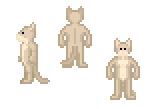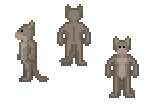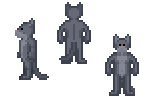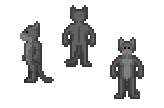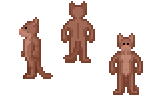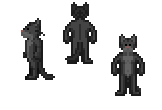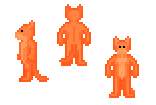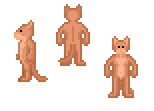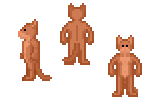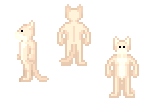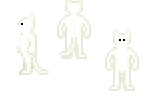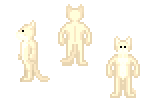Tajara: Difference between revisions
Biology stuff |
m Formatting |
||
| Line 21: | Line 21: | ||
To apply to be Tajara, apply [http://aurorastation.org/forums/viewforum.php?f=28 here]. | To apply to be Tajara, apply [http://aurorastation.org/forums/viewforum.php?f=28 here]. | ||
Additional information: [[Adhomai|Adhomai]] [[Notable Tajara]] [[Tajaran Military Structures]] [[Tajaran Ethnicities]] | Additional information: [[Adhomai|Adhomai]], [[Notable Tajara]], [[Tajaran Military Structures]] and [[Tajaran Ethnicities]] | ||
==Heads of Staff== | ==Heads of Staff== | ||
Revision as of 06:01, 25 October 2020
| Tajaran Lore Pages | ||
|---|---|---|
| Species and Ethnicity Lore Pages | Tajara · Tajaran Ethnicities | |
| Planet and System Pages | Adhomai · S'rand'marr · Hro'zamal · Gakal'zaal · Adhomian North Pole | |
| Culture Society and History Pages | Tajaran History · Notable Tajara · Ma'ta'ke Gods · S'rendarr and Messa · Tajaran Minor Religions · Tajaran Emigration | |
| Governments and Organizations Pages | People's Republic of Adhomai · Democratic People's Republic of Adhomai · New Kingdom of Adhomai · Tajaran Military Structures · Tajara Space Capability · Crevus · Little Adhomai · Free Tajaran Council · Tajaran Educational Institutions | |
| Lore Arcs | Tajaran Cold War Arc · Bad Moon on the Rise Arc · Ghosts of War Arc · Cold Dawn Arc | |
| Tajara |
| T. Sapiens |
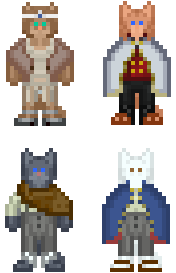 |
| Home System: S'rand'marr |
| Homeworld: Adhomai |
| Language(s): Siik'maas, Siik'Tajr, Nal'rasan, Ya'ssa, Delvahhi |
| Political Entitie(s): People's Republic of Adhomai,
Democratic People's Republic of Adhomai, New Kingdom of Adhomai |
Overview
The Tajara (direct plural: Tajara – Tah-jaw-rah both singular and multiple) (adjective: Tajaran - Tah-jaw-ran) are a race of humanoids that possess markedly felinoid traits that include a semi-prehensile tail, a body covered in fur of varying shades, and padded, digitigrade feet. Tajaran history and society is deeply entrenched in the conflict between its caste system and ruling governments. The species currently finds itself involved in a cold war between the three powers that control its homeworld, Adhomai.
To apply to be Tajara, apply here.
Additional information: Adhomai, Notable Tajara, Tajaran Military Structures and Tajaran Ethnicities
Heads of Staff
Hharar and Njarir’Akhran can be the following Heads of Staff:
- Head of Security
- Chief Medical Officer
- Head of Personnel
- Research Director
- Chief Engineer
- Consular Officer
- NanoTrasen Corporate Liason
M'sai can be the following Heads of Staff:
- Head of Security
Mechanics
- Tajara can speak a number of unique languages, such as:
- - Siik'Maas. Use this in-game by typing say ,j
- - Siik'Tajr. Use this in-game by typing say ,w
- - Ya'ssa. Use this in-game by typing say ,r
- - Nal'rasan. Only available to M'sai Tajara, use this in-game by typing say ,i
- - Delvahhi. Only available to Zhan-Khazan Tajara, use this in-game by typing say ,n
- All Tajara have claws and will scratch with them instead of punching, dealing extra damage.
- Tajara can see much better in the dark than humans.
- Tajara are less vulnerable to harm from the cold due to their fur but more vulnerable to harm from heat.
- Tajara cannot use human gloves or shoes due to their claws and digitigrade limbs. They are only able to wear voidsuits and voidsuits helmets designed/modified for their Tajaran anatomy. They are able to wear 'softsuits' (such as regular space suits, biosuits, and fire suits).
- Tajara have a higher nutrition and hydration threshold and process reagents slightly slower.
- Tajara have a set of organs adapted to the life on Adhomai, with some differences in regards to function and form.
- Tajara have access to an ability that allows them to see in the darkness.
- Due to a long history of combined selective breeding and cultural factors, different Tajaran races have different physical qualities and attributes as well as levels of education. Visit the physiology sections of the Tajaran Ethnicities page for information about their differences.
Coloration
Biology
To the average human, the Tajara share many similarities with Earth's felines; however, when looked at from a purely scientific perspective, this description is largely superficial. Unlike terrestrial felines, the Tajara are both omnivorous and bipedal. Their bodies are almost entirely covered in a thick coat of fur that is extremely good at insulating them from the extreme cold of Adhomai. The layer of body fat and fur is designed to trap body heat in an efficient manner. There are only a handful of areas where fur is not present, those being on the palm of their hands, the soles of their feet, and a number of various orifices as well as a small area around their eyes.
Occasionally, the fur around a Tajara's neck is known to grow into a shaggy 'mane' of sorts, giving them a distinct look not unlike a terran lion. This hair tends to be much stronger and a great deal wirier than the rest of the fur on a Tajara's body. Some Tajara tend towards monochromatic bodies while others have multicolor or even calico fur patterns. These designs depend heavily on the genetics of the individual's parents, much like hair and eye color. Because of this, some parents are utterly incapable of producing multicolor children. Designs including flat colors, stripes, spots, and most conceivable combinations have been recorded by scientists both Tajaran and human. A male Tajara is somewhere between 145 cm and 185 cm in height, while the mean body mass is between 55 kg and 90 kg. Females tend to range between 135 cm and 185 cm in height, with their own weight somewhere around 35 kg to 75 kg. As such, both their body weight and height is roughly comparable to the average human. A Tajaran fetus only takes six months to mature, and Tajaran children likewise mature rapidly, reaching the full extent of their growth by 15 or 16. This rapid maturation has a profound effect on the lifespan of Tajara, as only with modern medicine have Tajara reached ages above 70, with the oldest living Tajara being 84 years old. Most Tajara retire at age 60 when they are too old to work in any capacity.
Ethnicities
There are four races of Tajara: the Hharar, the Zhan-Khazan, the Njarir’Akhran, and the M'sai. Each race has a common role which they play in a society which their biological inclinations make them more suited for, as well as their own cultures which have formed from long histories of performing these roles in society. Tajara heavily stereotype each other based on race which is often a cause for conflict. As a result of these differences, there is a lot of racial tension between these various types of Tajara which was further exacerbated by differences in socioeconomic classes.
Hharar: the first Tajaran ethnicity who Humanity came in contact with is generally viewed as the 'typical Tajara', which is reinforced by their numerical superiority over the other groups. Additionally, given their large numbers and capabilities, they most often serve in governmental positions and as ambassadors to other races; this leads to them being taken as the 'face' of the Tajaran race, as it were. Hharar trend towards being the most intellectual of all Tajaran groups, and as such their physical prowess is significantly reduced. The Hharar are the stereotypical 'worker' Tajara, commonly described as loyal employees who are passionate and not afraid to voice their opinions.
Zhan-Khazan: the second most populous of Tajaran ethnicities, and are considered to be the backbone of the Tajaran workforce. Because of their history of hard work and the way they adapted to harsh mountain life, Zhan-Khazan are more physically intimidating than other Tajara. Featuring more toned, muscular bodies, thicker fur coats, and heavier bodyweight, they are well-suited to tasks requiring brute strength and heavy lifting. Due to their status as laborer they suffer discrimination and are usually regarded as less intelligent.
M'sai: the third most populous Tajaran ethnic group, the M'sai were at one point the hunters for ancient Tajara and evolved to have lithe, slender forms, and light fur that hid them in the blizzards on Adhomai. As Tajaran society advanced, M'sai could be found in many roles related to combat, including law enforcement and military service. They are very loyal to their friends and family but aren't as overt about it as the Zhan-Khazan. With wide eyes and acute senses, they make great soldiers, with vision adapted to compensation for the heavy blizzards that plague their home planet. They are also great survivalists and are capable of scrounging food for themselves via hunting.
Njarir’Akhran: the ethnic group that made up the majority of the plutocracy prior to the Great War. Their lineage can be traced from careful breeding between Hharar and M'sai, leading to where they currently are today. Following recent events on Adhomai, Njarir make up less than ten percent of the population. Easily identifiable by their large ears, fluffy tails, luxurious fur, and slender, elegant features. Njarir suffer persecution and rejection from certain proponents of Tajaran society because of their bloodline. As the most learned of all Tajaran ethnic groups, they boast high intelligence and have a propensity towards the arts and sciences.
For information about the ethnicities, their traits, and their cultures: see Tajaran Ethnicities
Tajaran Evolution
The Tajara evolved as a predatory, cave-dwelling species upon their home planet of Adhomai, and as a result, they have a pair of fairly large, well-developed eyes that are forward set. These eyes are comparable to those of humans, but they are more effective in low-light situations due to the Tajaran ancestors having to hunt in dark cave tunnels. Tajaran eyes are set above a slightly elongated structure comprised of hard bone similar to a muzzle on terrestrial creatures. Their pupils are large and capable of contracting significantly faster than most other creatures, both sapient and otherwise. This allows for a considerable degree of low light vision, however, they have a thin reflective layer that has the side-effect of appearing illuminated in the dark.
The Tajaran dental structure was at one point in their evolutionary history once geared for a carnivorous lifestyle but has since evolved and shifted towards a more omnivorous role. Tajara have sharp, needle-like teeth in the front of their jaw which is quite clearly geared to tear meat; the further along the jawline one goes, teeth similar to human molars reside behind the sharp canines, evidence of the change to an omnivorous diet. Evolutionary biologists believe that predecessors to modern Tajara had rough tongues with few taste buds in order to facilitate eating raw meat. The contemporary species has evolved out of this a long time ago in conjunction with becoming omnivorous, and so they now have softer tongues with a full sense of taste. Atop their heads, Tajara have a pair of deft, normally erect ears that are capable of a wide range of motion. They can rotate to roughly ninety degrees, capable of even being able to fold back almost entirely onto the skull if needed.
Extremities and Sleep Cycle
Tajaran extremities, specifically their hands and feet have five digits and are generally the same shape as human extremities. However, they are slightly stubbier in appearance, though still dexterous enough to be useful. Tajara employed in more professional roles such as engineers, architects, or other occupations that require dexterous manipulation often find themselves with filed down claws, reduced to a smooth end in order to allow easy usage of standard human-based technology. This is a task that Tajara tend to do reluctantly, given that cutting too short is incredibly painful and will expose nerves to the air. Normally, these claws are non-retractable and grow from the fingertips, usually measuring around 1-2 centimeters.
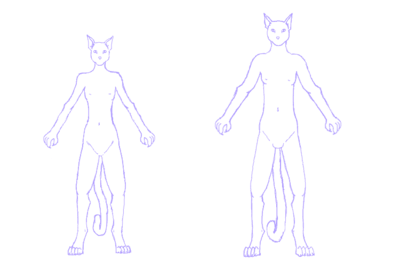
The sleep cycles of the Tajaran species are one of their most scientifically curious features. A normal waking period is somewhere between thirty-six and forty-eight hours, with a subsequent twenty to twenty-eight hours of sleep. Normally, the waking period is spotted with three to four fifteen-minute naps in order to keep the Tajara refreshed and alert. This is universal in all worlds with Tajaran living upon them. Tajara are capable of great feats of intelligent, dedicated work but this is physically exhausting, which renders them utterly mentally and psychologically exhausted. Those that do not enter their sleep cycle properly may find themselves groggy, aggressive, paranoid, and disoriented until their circadian rhythm is righted.
Tajaran Build
In comparison to most other known species, the Tajaran body is designed to specifically be more flexible, lithe, and slender despite their thick insulation. A handful of Tajaran ethnicities do not exhibit these traits and instead manifest increased muscle size, strength, or bulk. Tajara are sexually dimorphic; females have more elongated muzzles, shorter ears, as well as more petite forms, and their distribution of body fat is entirely different than that of a male. Females do not exhibit visible breasts until pregnancy, at which point they swell in order to provide for young. Males are in general taller, have broader shoulders, bigger hands and feet, and more pointed ears.
Tajara are built for extremely low-temperature environments that are incredibly common on Adhomai, giving them remarkable cold resistance. However, this gives them a tendency to overheat in more mild environments. To avoid this, most Tajara will dress lightly in warmer environments such as those on human installations or tropical worlds. Forgoing the usual layer-like clothing, these Tajara resign themselves to thin clothing. Those who find themselves confined to bio-suit or radiation suit for extended periods of time will end up feeling extremely uncomfortable and perspiring heavily.
History
Nobility and the Ancient Past
For as long as Tajara care to remember, Adhomai had always been under the rule of the nobility. The oldest historical text that exists in Tajaran possession dates back at least three thousand years and talks about the presence of nobles. Many historians agree that the trend of blood rule is more deeply-rooted in Tajaran existence than was before considered.
The ancient past of the Tajara is poorly documented and historical texts are rare; meticulous combing and destruction of educational material by millennia of harsh rule resulted in total atrophy of most scientific arts in Tajaran society. Little is known about Tajara civilization before 1500 BCE Galactic Standard Time.
The earliest form of government were local monarchies supported by religious authorities; the ruler and their families were considered of divine origin. Most of the settlements were similar to rural fiefs, with the population working for those dynasties in trade of their protection. Urban centers started to appear around places of worship. Peasants had little to no rights, and all dissidence was met harshly and fatally at the hands of the Nobles' Enforcers - trained agents (commonly of M'sai descent) who fought for the nobility of Adhomai in exchange for relative freedom. These Tajaran enforcers kept the peasants of Adhomai's lands repressed and powerless through shock and terror.
What is known for sure, however, is that tension and violence had slowly been increasing over hundreds of years between the populace and their fellow noble families.
Tensions Rise
Tajara historians believe that global violence spilled out across the planet between the kingdoms and the other scattered noble families in 80 CE. Those states clashed and either pitted their followers against one another. The noble leaders continued to fight and inter-marry until the ruling families had become exclusively Njarir’Akhran. Over time, the nobility as it slowly began to lose their religious inclination, adopting more traditional civil institutions and a relaxation of the church's control which gave way to state control. Religious worship of the noble families had been dropping steadily in conjunction with the lower influence they had upon the other nobility. It was this period that historians believe the overwhelming control of the noble families flourished and solidified into what it was prior to human contact.
Even with technological and governmental advances, the Adhomian society was stuck with its old feudal system. The tension between nobility and the peasantry increased due to new burdens brought by military campaigns. The first writings against the serfdom and caste systems started to appear around 1732 CE, with those early revolutionaries being dealt with violence by M’sai enforcers. Draconian laws and sanctions were introduced against those that defied the status quo. Relations between the ruling class and commoners were precarious, believed to have stemmed from harsh rulers and laws. Technological and cultural knowledge and breakthroughs had begun to trickle down from the noble families to the peasantry. The invention of the printing press in 1756 CE favored the spread of anti-monarchist pamphlets. Owning a copy of an unapproved text was a capital crime.
Adhomai underwent a form of industrialization with the creation and proliferation of the steam engine in 1954 CE. However, this only forced the Adhomai peasants into harsh new labors digging in mines and working 18 hour days building rail lines for private use by the Njarir’Akhran nobility. Laws were soon enacted that banned any non-Njarir’Akhran from utilizing electricity or riding on trains. This trend of noble's hoarding new technology or innovations at the expense of the peasants continued until human contact.
Thirty years prior to the human discovery of Adhomai, the deep-seated mistrust between peasants and nobles had reached an all-time high. The Tajaran species was trapped in a technological bubble forced upon them by their nobility. At the height of their industrial revolution only a few years prior, the leadership at the time became increasingly wary of the unification of many Tajaran workers who demanded greater rights. The realms of education, science, and luxury found themselves under severe restrictions, and your basic Tajara was forced into almost twenty-hour workdays with the minimal time afforded for eating and sleeping on the job. Analysis of the noble houses proves that during this time in Tajaran history, the nobility had never been worth more in Sol credits than previously. This is largely attributed to the fact that rather than modernizing Adhomai the nobility had seen fit to confiscate and use these fruits of scientific thinking for themselves.
Automobiles are considered one of the best examples of this. The first automobile is recorded to have been created in 2292 CE. Using a combustion engine much like primitive human vehicles, with extra anti-freezing measures and thick treads, one of the first fully functional automated cars had been produced by a collection of Tajaran engineers and scientists, at the behest of the nobility. These large creations were considered by many older Tajara to be a symbol of negligence and gluttony by their leaders. Workers were never provided with such things; they were forced to transport themselves through Adhomai's harsh winter conditions on foot or by using specially designed 'snow bicycles', regardless of how far away their place of work was.
Further restricting the rights of the individual Tajara was enacted by a furious nobility after several instances of violence against Njarir’Akhran, but specific information on these incidents has been lost. Legislation was introduced against 'workers unions' as well as any sort of illicit groups; a permit was required to form anything from hunting parties to agencies. In this whirlwind of political turmoil, a fresh generation of Tajara were growing up, deprived of what most humans consider to be 'basic rights'. As they grew older and angrier, the nobility saw fit to continue tightening their control over their subjects until a civil war was almost inevitable. Like a powder keg ready to blow, only a single spark was needed to light the flame.
Human Discovery
This came in the form of human discovery in 2418 CE. A Sol Alliance funded expedition into the Tajaran home system discovered the pre-space age species and their homeworld of Adhomai. Lush with untapped resources and potential workers, Adhomai was an attractive prospect for many human super corporations, especially NanoTrasen. Because of their slow technological progress, most of Adhomai's valuable minerals remained untapped by mining or drilling. It was due to this that several corporations attempted to insert themselves into the dealings of Adhomai.
However, the nobility felt incredibly threatened by what they considered 'intrusions' by humanity and completely refused them diplomatic access to their planet. The Alliance stepped in, initially unwilling to interfere in a pre-space age society and, reluctantly, the super corporations were forced to abandon their wishes to stake claims on Adhomai's resources - at least in the open. In the year 2420 CE, a group of Tajaran intellectuals - considered rebels by the state - were shuttled off-world by a still unknown entity. Given asylum in the Sol Alliance, they met and discussed much with human scientists and officials. Tensions between the Alliance and Tajaran nobility rose after such an event and they accused the humans of harboring terrorists.
Eventually, these rebels were returned to Adhomai with supplies and weapons. Fed with new ideals of personal freedom and 'rights afforded to all' by their influential human friends, the seeds of revolution were sowed among the Tajaran populace, spread by word of mouth. Workers, doctors, teachers, even soldiers that were questionably loyal to the nobility were swayed by these promises of freedom and equality. Meetings in the basements of dark taverns or barns were common, and relations between the nobility and their peasants were at the lowest ever recorded in Tajaran history.
The Uprisings
It took little more than a year for a formal uprising to be staged. On 2421 CE, after the nobility had captured one of the original Tajara that had been shuttled off-world, he was sentenced to be publicly hanged by the neck in front of their peasants to show just how serious they were about keeping control. Ultimately, many historians believe this to be a highly egregious mistake. Rebels in the audience, armed with advanced off-world weapons, proceeded to open fire on loyalist forces and kill a nobleman in the process. This event, called the D'as'ral Massacre (so named for the city it took place in) by the nobility was all the excuse they needed to enact martial law.

However, they found themselves in a cornered position. Weapons and supplies were being shipped in off-world by mysterious benefactors, and their collections of scientists and engineers had either fled to safety being noblemen themselves, or took up arms and joined the revolution. Without significant scientific presence to deconstruct or understand these new human weapons or support the war effort, the conflict resulted in a string of rebel victories that drew closer and closer to the capital cities of each providence. Fighting was extremely fierce and atrocities were recorded by both sides.
Among the noble families, the largest and nearly the most powerful was a dynasty called the 'Hadii'. Their castle was amongst the best defended in the region and the battle to take it was waged for six months of non-stop fighting. As it became increasingly clear to them that they were eventually going to be overrun, the Hadii struck a deal with the rebel leader; in return for complete immunity from the war, as well as persecution, they afforded the revolutionaries with unique tools and even blueprints of other families' castles, pointing out weak points and infiltration spots.
It was this turn coating that tipped the revolution in favor of the peasantry. Armed with this new information, they made use of radio systems previously restricted for nobility to methodically and ruthlessly end their uprising by murdering most of the noble families, and whatever soldiers and civilians remained loyal to them. By 2431 CE the revolution had finally come to an end with a total of more than 92 million casualties with more than half of that being loyalist forces and 40 million civilian deaths. Many Tajaran cities and villages were utterly destroyed by vicious fighting as well as bombardment by uncaring nobles. An informal ceasefire was declared between the factions, though skirmishes were still common.
Outcome of the Revolution
Following this total upheaval of Tajaran society, rebel leaders met with Hadii noblemen and discussed how to form a government, given that only the Hadii were experienced with the ruling. Human corporations took an express interest in this; the Hadii were one of the few noble families that saw profit in human stakes on Adhomai, and many back-room deals were made until ultimately the Hadii were placed at the head of Tajaran government in 2432 CE, and ushered in a new federal republic: The People's Republic of Adhomai. The Tajaran public was markedly distressed by this turn of the events, and fearing another uprising, human intervention again helped defuse the situation. The Hadii promised that it would not be like it was before.
NanoTrasen, suspected by many conspiracy theorists to be behind the funding and supplying of Tajara during the war, holds claim to most of Adhomai and has a monopoly over most of the planet's valuables. Collaboration between them, the Sol Alliance, and the Jargon Federation have resulted in more technological advances in Tajaran society recently than ever before in their recorded history. Approval ratings for the current leadership rose in response.
However, serious problems remained. Rhagrrhuzau Hadii suddenly began to back out of the People's Republic's agreed-upon business deals with NanoTrasen, all of which saw a massive amount of Tajaran natural resources exported. Citing humanity as greedy and destructive, Rhagrrhuzau Hadii made clear his intentions to make Adhomai independent until it was ready to take on the burden of interstellar politics.
The Second Revolution
The disagreements and hatred of the Hadii republican government had led to insurrection and treachery between Adhomai's major power figures since Rhagrrhuzau Hadii's new economic policies were revealed. Many Tajaran business contractors - just recently denied their ability to sell ludicrous amounts of natural resources and workers to the massive human megacorporation, NanoTrasen - felt threatened by the reforms of the Hadii government and its first President, Rhagrrhuzau Hadii. On 2451 CE, during a military parade, President Rhagrrhuzau was assassinated by a young Zhan-Khazan radical. A known secret service agent of the People's Republic, the radical was sentenced to death for his treachery, brought on by the violent tendencies of his Zhan-Khazan genetics. His brother and vice-president Njadrasanukii Hadii quickly assumed the office of the presidency and immediately passed brutal laws that punished the Zhan-Khazan and 'subversive elements'. NanoTrasen was invited back to Adhomai and menial workers were sold en masse to NanoTrasen workplaces while the rights to the bountiful natural resources of Adhomai were sold off to NanoTrasen. Public hangings and firing squads became the norm once again.
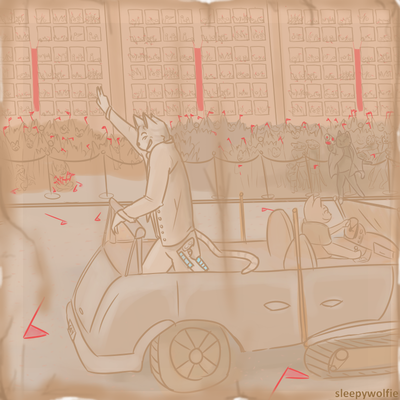
Many military generals that had fought for the Republic soon defected under the banner of the Adhomai Liberation Army, the leader of which being Rhagrrhuzau Hadii's old friend and ally, Halkiikijr Nated'Hakhan, and Adhomai found itself embroiled in yet another global conflict that continues to this day. "His gun was on stun" became the rallying cry of Rhagrrhuzau's fiercest supporters, "Hadiists," as they alluded to how he not only left himself greatly vulnerable during the parade, but had even left his energy pistol on stun while he was assassinated.
Adhomai Today
The Tajaran home world has suffered plenty in the three decades since the end of the First Revolution. With the sudden injection of advanced technology into their relatively simple life, the discrepancy between modernized cities and outlying areas could not be more obvious. While the Tajaran capital boasts the most modern developments with sleek skyscrapers, advanced connections and phone lines, as well as hospitals and schools, the further you get from the larger cities, the more apparent it is that things are not quite so flashy. Expanding infrastructure remains difficult, as most public funds are seized for use by the military or used to repair infrastructure damaged by shelling or bombings.
There is a steady stream of money being fed into the People's Republic of Adhomai. NanoTrasen, as per it's agreement with the president, have set up mining and logging operations on Adhomai using the local workforce for the most menial of tasks. In return, company-funded clinics and schools are slowly being spread out and build in needy areas. Tajaran resource operations are now all but nonexistent; the buildings that were once part of the nobility's small gathering efforts have now been refurbished and are being used by NanoTrasen.
Literacy has risen to its all-time high on Adhomai, and with the assistance of the Alliance, teachers have been brought in from off-world to educate the younger generation of Tajara. However, this number has begun to decline as the dangers of working on Adhomai are beginning to become common knowledge. Special establishments for older students have also been constructed to assist the elder generation in being brought to the same level of education, but NanoTrasen has not expressed significant interest in this; these people make up the brunt of their low-paid workforce and they want to ensure that they are kept that way.
The second revolution came to an end in 2461, after a decade of warfare between the three factions. The People's Republic of Adhomai was driven off from many of its past territories, having to rely on the help of a coalition of allied states and mercenaries to stop the enemy offensive. After months of bloody defenses, guerrillas attacks, and complete stagnation of all fronts, a ceasefire was signed with the support of Tau Ceti and Jargon. An armistice, known as the Armistice of Shastar, was signed by the three factions shortly after. With the recognition of the Democratic People's Republic of Adhomai and the New Kingdom of Adhomai by the galactic community and the enforced peace, the three Tajaran powers are eager to compete with each other for supremacy through a cold war.
One of the clauses of the Armistice of Shastar was the creation of the Tajaran Citizenship Act; a legal provision that allows DPRA and NKA citizens to legalize their citizenship situation, forfeiting their previous PRA affiliation. Tajara living outside of S'rand'marr are able to request the transfer through the proper diplomatic services.
More information: Tajaran History
Tajaran Factions
Adhomai is controlled by three factions, that once participated in a civil war for the control of the planet.
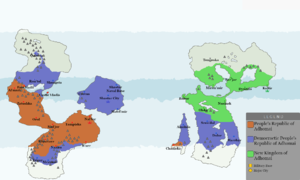
Lead by President Njadrasanukii Hadii, the People’s Republic of Adhomai are considered the 'loyalist' faction on Adhomai and once enjoyed galactic recognition as the government of Adhomai. It claims to be the true keeper of Al’marii’s legacy. However, the PRA can be described as a Hadiist branch of Al’marii’s revolutionary ideology - that means putting the State at the top of a hierarchy of power. The PRA is a very centralized state, but in recent years has slowly been able to start making true its promises to bring revolution to the masses. With land reform, the enfranchisement of women and peasantry, literacy initiatives, and the collectivization of farms and the means of production, the PRA is struggling to hold true to its radical ideals while an entrenched upper party stubbornly tries to hold onto power.
More information: People's Republic of Adhomai
The most pervasive and successful rebellion came from a group calling themselves the Adhomai Liberation Army, a group made up of Tajara from almost every walk of life. Opposing corporate claims on Tajaran soil and citing mismatched development and governmental negligence as the fault of humanity, they aim to "free Tajara from the new shackles imposed upon them by the corporate overlords and return Adhomai to a free, prosperous planet like our ancestors dreamed of." They named the nation they were fighting for the Democratic People's Republic of Adhomai.
The DPRA is now lead by President Almrah Harrlala who is struggling to transition what was once a militant insurgency movement, then an organized military, into a modern, democratic nation. With the help of Nated as a government minister going out to negotiate with ruling Juntas to voluntarily turn over power to civilian governments, many of which still refuse, the DPRA's future faces many fundamental changes. The Liberation Army and the DPRA does, for the most part, try to respect the basic rights of Tajara. Most Tajara under their rule doesn't need to worry about a secret police or being framed for a crime for civil disobedience. Criticizing the Liberation leadership is allowed, and many powerful figures laugh along with searing satire targeted at them.
More information: Democratic People's Republic of Adhomai
The last major faction is the rebellious New Kingdom of Adhomai, which seceded and declared itself a nation in 2450. The New Kingdom is ruled by a Njarir’Akhran noble line that survived the previous Revolution by remaining in hiding, owing to the efforts of their supporters. Ruled by King Nazira Ka'rimah (Vahzirthaamro Azunja) specifically, he denounces both other factions in the civil war as illegitimate and himself as the only legitimate ruler of Adhomai. Supporters of the New Kingdom tend to be rare outside lands it controls. However, they believe strongly that the current republic on Adhomai was founded on genocide and unspeakable slaughters. The New Kingdom puts forth the ideology that Republicanism is bloodshed. The only way to return Adhomai to peace and prosperity is to learn from the mistakes of the ancient nobles and Republicans and create a new noble dynasty. They believe this dynasty should rule as a constitutional monarchy in order to prevent abuses of power. The lofty titles of the nobles disguise the fact that most of the nobility of this new kingdom remain in squalor only marginally better than the peasants. Life is difficult, but improving since the end of the war. The Ka'rimah dynasty finds itself struggling to function with its limited constitutional powers and factional in-fighting between the military and the civilian government.
More information: New Kingdom of Adhomai
Social
Native Tajaran names are usually difficult for humans and other species to pronounce properly; as such, Tajara prefer to take names that they find they themselves can pronounce and are also phonetically pleasing. For many, these are names derived from Arabic or Russian backgrounds, as they are the easiest for their inhuman mouths to pronounce.
Traditionally, Tajaran names included the name of the dynasty they served, and some Tajara carry over this tradition and have their 'middle' name be their dynasty's name. Other, less fortunate Tajara took up names that denoted their status in the community or aspirations for the convenience of others. This tradition is where the concept of taking up names originated from, thus a Tajara will usually have a given child name and a taken up name, with perhaps the dynasty they 've served as their middle name. This is different for the members of the PRA, as president Hadii issued a decree that all Tajara are to change their names to their parent given names, to encourage party loyalty and pride of tradition. While most dedicated Hadiist have chosen to return to their native names, many Republican Tajara still use their adopted name within and outside of Adhomai.
As with all other species who work in Human-centric environments. Tajara are expected and required to have passed a prerequisite test to test their comprehension of Tau-Ceti basic, the operating language of NanoTrasen and most transstellar corporations, in addition to most major sovereign entities. Admittedly the passing levels of these comprehension tests are quite low, but are high enough to ensure basic conversation between what will likely be a multi-species crew. However, private communication in Siik’Mas or Siik’tajr is not forbidden by NanoTrasen regulations and is often used to hold conversations between Tajara on the crew.
Though there are a variety of languages used by the Tajara, among the foremost of this vast plethora of languages is Siik’mas and Siik’tajr.
Siik'maas is theorized to have been the ancient language of the Tajara, the 'religious' tongue shared between most Tajara from their onset as a species. Despite Tajaran society evolving to a point where religious devotion became less encouraged, the universal service language used in all churches and worship sessions became the lingua franca and almost every Tajara knows how to speak it. It has been taught as the primary educational language amongst most Tajaran ethnicities since the Migration Age and continues to be the most prevalent tongue on Adhomai since.
It is capable of being spoken by a learned human, as it is not as reliant on body language as Siik'tajr or the other native languages on Adhomai. However, just as Tau Ceti basic is difficult for Tajara to master given their muzzle structure, Siik'maas is the same to humans, since they lack the proper biology to perform certain inflections properly. Despite focusing more on spoken word than others, some of the vocabularies require subtle body movements that are challenging for humans to grasp, no less perform. Even if one were to learn these movements, they tend to be sluggish and slower, giving the speech a sort of 'drunken' feeling. Tajara speaking this over the radio often find themselves in similar positions.
Siik'maas is the federal language of the People's Republic of Adhomai. However, several groups of Tajara ranging from scholars to traditional followers of the old ways are attempting to revive older languages such as Nal'rasan, Delvahhi, Ya'ssa, and other such languages.
Siik’tajr is the opposite of Siik’mas completely. A recent construction, it has seen more use recently following the overthrowing of the plutocracy. It was birthed from the necessity for a language that was difficult for law enforcers to understand, enabling revolutionaries to converse privately without having their conversations monitored or overheard. Revolutionary radicals have been a part of Adhomai's history for a long while, but were always small; however, when the Great War broke out, Siik'tajr saw widespread use by rebel forces during military operations similar to Navajo radio operators. It is a combination of Siik'mas and the more body language inclined Nal'rasan, a tongue traditionally used by hunters. It is not normally used in daily life due to its complexity, it is often maintained as a secondary language, especially for families who fought in the Great War.
Pro-human groups within Tajaran society have repeatedly attempted to push Cyrillic or Latin alphabets as 'easier to use' rather than the native Tajaran alphabet. However, the vast majority of Tajara use the old Siik alphabet and it is the federally enforced alphabet taught in schools, the original alphabet learned Tajara have been using for centuries. It has undergone certain modifications since the Great War to remove the influence of the plutocracy and has made a widespread comeback with increasing literary levels among the Tajaran public.
Tajara have a strong biological inclination to roll the “R” sound, extending it. They also tend to refer to themselves in the third person perspective instead of the traditional first-person ( “He has completed his work" instead of “I have completed my work") though Tajara who have spent a large amount of their lives in space or among other species may overcome this trait with great difficulty. Most Tajara will only speak to someone in the first person if it is someone they trust substantially. The occasional “slip up” can still be expected, however, as being surrounded by a mostly Human crew can occasionally confuse them into using the first-person. The second person perspective is used in many regional dialects and does not imply any intimacy, however many Tajara prefer the third person even in these cases as a preference. The first-person perspective is often used in the context of speeches or addresses to large populations in order to enhance the rhetorical impact.
Religion
S'rand'marr Worship
"By day and light of S'Rendarr, we live and bask in his warmth, happy and content. By the warmth and light of Messa, we cease breath and fall to death. Only by the love and harmony of both the Twin Gods and Sibling Suns do we live happily, and die the same. By the Twin Gods and Sibling Suns, S'Rendarr and Messa, the faithful ask for your blessing, and to please extend it to the non-faithful who do no wrong, and cast no sin."
- The "First Prayer" of S'rand'marr Worship
There are a handful of faiths on Adhomai, but the majority religion is the worship of S'rendarr and Messa, the names of both suns in the Tajaran home system. Ancient Tajara were believed to worship the suns as gods, believing their light to be the only thing keeping the planet from freezing over entirely. Over time, this faith matured into a system of beliefs suited to the peasantry; looking down upon the acts of betraying your fellow worker and attempting to foster unity and understanding amongst its followers. It is believed by many that S'rendarr is the god of life and the day, as the bigger of the two suns, and he is associated with good happenings and is most often prayed to. Contrastingly, Messa, the blue sun, is the goddess of the night and death; whenever she eclipses S'rendarr, all followers partake in religious rituals that ask Messa to spare them from whatever ill tidings she may bring. The worship of the sun gods is dominated by an organization called the Parivara, meaning, the "Family." The head of the Parivara is Father Walid Al'qat who is based out of Sana Sahira, a holy city on the tallest mountain on Adhomai which roughly translates into the City of the Suns. The First Father of the Twin Gods was said to have made a direct link with the Gods, who gave him these laws that all of their faith should follow:
"You shalt not harm another, faithful to the Suns or not. You shalt always show kindness to any and all. You shalt not covet the items of another faithful. You shalt not defile the body of one who now rests in Messa's Forever."
Since the day these were declared in Sana Sahira, they have been considered the Law of the Suns. This location in the People's Republic places the Parivara in the precarious position of having to act favorably to the faction's government, however, Father Walid Al'qat attempts to stay out of politics in order to avoid alienating any worshipers across borders. The Father of the Parivara is chosen by the Brothers of the Suns who serve as the priests and clergy of the faith. Devoted women of the faith can become Suns' Sisters, who take a vow of silence, like the Gods themselves, and live in the temples devoted to the worship, tending to them in any way needed, anything from cleaning to heavy manual labor repairing and replacing glass or furniture, to healing the Brothers, patrons and other Suns' Sisters. To cause harm to a Suns' Sister is said to be one of the most unholy things you can do in a place of worship, as they're meant to emulate the Gods themselves, silent, but strong and dependable.
Ma'ta'ke
The second-largest religion is the worship of the Snow God Mata'ke and his cohort companion gods, which dates back to ancient Tajaran times. A figure of legend, Mata'ke is believed to have been the head of a hardy tribe of mountain dwellers that regularly came to the aid of other tribes that were constantly plagued by bandits and wild animals. He was revered as a fierce warrior capable of fighting a platoon of men by himself, but also as a kind soul for the records of his dealings with other tribes shows understanding and kindness. He is upheld to be the ultimate Tajara- powerful, wise, and magnanimous. Followers of Mata'ke himself endeavor to emulate his grandeur, while others attempt to emulate the other gods.
In Tajaran mythology, the tribe of Mata'ke rose to the status of gods when they slew the King of the Rrak'narrr, who was also the lord and master of all Adhomai. Upon killing him, the various tribesmen all absorbed different aspects of its many powers, each becoming immortal. As the one who dealt the killing blow, and at the will of the dying Rrak'narrr's final wishes, Mata'ke absorbed the majority of the powers and became lord and master of all Adhomai. The tribe then decided that their former settlement was not befitting of their powers, and instead established themselves in a city of wonders at the "Edge of Adhomai" where they fend off malicious entities and protects all Tajara.
Njarir'Akhran Worship
At one point, a religion was established heralding the nobility themselves as gods by certain devout loyalists, but this faith has all but been completely erased following the uprising. Individuals who were recorded to believe in or are suspected of being a member undergo persecution and even in some cases death sentences. With most loyalists either in hiding or killed during the uprising, and all places of worship destroyed, any intelligent Tajara would never admit to being or attempt to defend, a member of this faith.
Culture
Fashion
Throughout Tajaran history, fashion has remained relatively simple. Extravagant vestments fabricated from silk and other high-quality animal hides were restricted exclusively to the nobility, and standard Tajaran peasantry had little time to choose their uniforms, usually donning overcoats made of rough fabric and patches of animal hide. The fluffier the design was, the wealthier a noble was considered.
Given the hardships of Tajaran life and the constant need to do work by hand, the peasantry came to favor practical, well-insulated clothing rather than fanciful designs; they were also cheaper to weave, which made things easier on the weaver. Underwear usually came in the form of long-sleeved pants and a shirt typically woven from thick animal furs and plant fibers and is used as the innermost insulating layer. Then, a Tajara would overlay multiple garments to create several layers of insulation to stop the loss of body heat. Thick, full-length skirts, pants, and shirts were favored by the peasantry, all in dark colors to retain heat better. Typically pre-discovery and even post-discovery modern clothing consist of thermal underwear, pants for men or long, heavy skirts for women, with thick sweater-like shirts and fur cloaks.
The feared enforcers of the nobility wore great suits of armor designed to seal the user inside, creating an environment that was completely isolated from the harsh snows of Adhomai. Build for brute strength rather than comfort, the helmets of these suits made no room for Tajaran ears. These 'Enforcer Shells', as translated from Siik'maas, were usually brown or olive in color, with slit visors that masked the wearer's face.
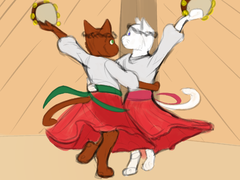
Today, the Government Officials of the People's Republic of Adhomai are usually seen dressed in olive military fatigues, occasionally donning a commissar-styled cap. These caps are usually styled with small rosettes to signify authority. When in especially cold weather, officials usually layer on black trench coats and scarves rather than wearing the outfits of the lower class.
The lower and middle class of the Tajara are better heated by proxy, and can comfortably wear flat caps and long-sleeved buttoned shirts for warmth when working in their factories rather than excessive garbs. When outside, typical Tajara will wear bomber jackets or fur coats with additional fur padding on the interior to better trap heat, paired with traditional slacks. Headwear for these working-class citizens usually comes in the form of full head scarves to keep ears warm when in the wilderness, and standard soft and flat caps within cities.
Cuisine
Similarly, due to the cold temperatures of Adhomai, Tajara favor warming or hot food that can be consumed quickly before the freezing winds can cool the meal off. Porridges, soups, and chowders consisting of diced meat and vegetables for flavor was the usual meal of a working-class Tajara, coupled with some bread and water or ale. Pre-industrial Tajara used to have community meals around bonfires to keep their food from cooling off too much, and almost all of their food source came in the form of porridges and oats. However, with the introduction of new technologies - such as higher quality insulation and home heating systems - Tajaran cuisine is being experimented with by chefs who are no longer restricted to compensating for the naturally low temperatures of Adhomai. Historically, culinary creations were reserved only for the nobility, who had better-heated homes than the peasantry, and more leeway was offered towards not having your meat turn blue in front of you.
Traditional stews are made with diced vegetables, such as Nif-Berries, and meat, Snow Strider is commonly used by the rural population, while industrialized Fatshouters's beef is preferred by the city’s inhabitants. Tajaran bread is usually made with Blizzard Ears’ and consumed during their morning meals.
The Adhomian hard bread is a type of tajaran bread, made from Blizzard Ears’s flour, water, and spice, basked in the shape of a loaf. It is known for its hard crust, bland taste, and for being long-lasting. The hard bread was usually prepared for long journeys, hard winters, or military campaigns, due to its shelf life. Certain folk stories and jokes claim that such food could also be used as artillery ammunition or throw at besieging armies during sieges.
Adhomian alcoholic beverages are made with fermented grains, fruits, or vegetables. Juices are commonly mixed with sugar or honey. Victory gin is the most widespread alcoholic drink in Adhomai, the result of the fermentation of honey extracted from Messa's tears, but its production and consumption are slowly declining due to the People’s Republic political situation in the current conflict. Messa's mead is also another more traditional alternative, made with honey and fermented Earthen-Root juice.
Fishing and shellfish has a part in the diet of the population at the coastal areas, even if the ice can be an obstacle to most experienced fisherman. Spicy Ras'val clams, named after the sea, are a famous treat, being appreciated in other systems besides S'rand'marr.
The Arts
Of all arts, music is one of the most highly valued by Tajara. Stemming from the long-standing ban on most literature in their society, song, and dance remained one of the only ways for Tajara to express themselves through words. Composers and musicians were traditionally held in high regard amongst Tajara, and in place of books, the fanciful song-stories of traveling bards were one of the few ways the public could remove themselves from their lives.
Theatre was also equally important in the life of a pre-discovery Tajara. Given that, with the lack of books, there was little to keep your usual worker entertained, the ability to watch and enjoy a riveting drama or hilarious comedy was heaven. Theatres and performing halls can be found in almost every Tajaran village, and are often constructed to rival even the main seat of the town council or government in architectural beauty. For example, the D'na'tel Hall in the Nal'tor was one and a quarter larger than the seat of government prior to human sanctioned expansions. Dating back to the late Gunpowder Era, it was constructed from high-quality marble and many sculptures of characters and scenes from various popular Tajaran plays were meticulously hand-carved into the walls by sculptor Nasir Ka'nira.
However, literature itself - that is to say novels - have never been looked kindly upon by the Tajara public. Though this closed way of thinking is starting to shift with the greater introduction of literacy amongst Tajara as a whole, many elders still harbor bitter feelings about books in general. They were almost universally considered a symbol of oppression and luxury by pre-revolution Tajara, given the fact that only the nobility were taught en masse how to read, and that every family had its own private expansive library that even learned peasants had to pay out of pocket to access. This led to widespread destruction of much of historical Tajara texts following the uprising, as revolutionaries took it upon themselves to purposely gather and burn whatever books they could after taking a noble stronghold.
Music
Tajaran music is modally-based, with there being eight modes in total. A scale can be constructed from each Mode, which is the arpeggio of the mode. There are a total of four notes in one modal scale. Two are octave, and there are two in between. Microtones between the two notes in between are used frequently, which would sound very odd to human ears. This is done because Tajara perceives music as sadder with the flatter a pitch is, and happier with the sharper a pitch is. Depending on the mood of a song, a Tajara player may tune their instrument lower, to make the song sadder; the opposite is also true. A common tradition is to let the weather decide the tuning of an instrument. Cold weather naturally makes an instrument flatter, ergo colder weather will make songs sadder. And indeed, one may notice that if each note is perceived relative to the notes that come before it, there will always be a happy and sad part integral to the song. This is on purpose, as it reflects the duality in sadness/happiness which is also found in S’rendarr and Messa. Some Tajara may also associate Dissonances to Raskara.
The eight modes are respectively named: Mrazur, Manur, Rrauor, Surour, Kaoel, Draeol, Aauol, Deor. They are associated with the main Ma’ta’ke deities: Mata’ke, Marryam, Rredouane, Shumaila, Kraszar, Dhrarmela, Azubarre, and The Dead Gods.
A side effect of the Tajaran caste system is the possibility for the ethnicities to usually have different possible ranges and timbres on their voice. Zhan-Khazan are commonly a Bass-Baritone voice. Hharar are Tenor-Alto. M’sai and Njarir are almost always Sopranos. The voice is the most universal Tajaran instrument. Due to traditional schooling, many children have at least basic singing skills, though this is fading away in the cities.
Notable Folk Instrument
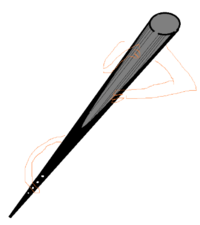
P'rrama: An plucked string instrument, with eight strings and four holes at its end. The holes on the bottom change the octave of the notes that are played, thus extending the range of the sounds. It is used both solo and with other instruments. Humans can play it, but the octave range is disabled due to a lack of a tail.
Makkra Baq: This instrument that hails from the island of Das’nrra, but it has long been a staple of Tajara everywhere. One plucks the strings, creating a meek and Harpsichord-like sound. It is almost always used in a solo or duet setting, as its small voice can easily be overshadowed by other instruments. In spite of this, it maintains quite a folky sound, and it is more common in rural areas than in cities.
Mah Kii: The Mah Kii is an ancient instrument, used by Tajara since the Migration period. Adapted from a horn used to rally soldiers, it has a strong divine connotation. Many believe that one will hear its sound when entering the Holly Village or when joining Messa in the afterlife. Rhazar’Hrujmagh caravans still use this trumpet at the start of raids. Some have even attempted to incorporate it into Electro-Swing bands. However, due to its short-range and its connotation with the divine, it is not used often.
Sports and Games
Recreation time for most Tajara has always been limited. Oppressive work hours and strict caste rules disallowed leeway for what a Tajara could do in their free time. Organized sports were a product of the Njarir class, that would find themselves with more time in their hands. However, as time marched on, Tajara of lower classes found ways to still play. In modern times, any Tajara is usually able to participate in any sport they wish.
The notion of video games is unknown to natives on Adhomai; as computers are usually seen as tools. However, the younger generations living in Little Adhomai have taken interest in electronic games and arcades. Many independent productions have started to appear, with software being shared through the extranet or data storage devices. One popular title is “The Bane of Rashashana’: which follows the tale of an Adhomian folk hero attempting to save the Paspitami’rran from a malicious monarch. The player can make narrative choices that affect the story, interspersed with objectives such as running and managing a limited time meter while avoiding obstacles.
Notable Sports
Farehal: A sport that focuses on accuracy. It consists of the player throwing a disc through several hoops scattered around a course. The distance and the difficulty of the shoot influence the score. The player with the highest point value wins. Due to the amount of space needed for Farehal, especially for multiple matches on the same course, due to this, it was only practiced by the nobility at first. Large buildings were constructed to host Farehal, where noble competitors played. This game is seen as extremely pretentious, with critics claiming it requires no real strength or skill to win. It has not seen much popularity outside of S'rand'marr, but it is moderately popular on Adhomai, with teams competing within their own countries. Al’mari Hadii used to be a famous Farehal player.
Mahmrro: A sport that requires the Tajara to capture a ball and either run it to the opposite side of a field or throw it to a team member located on that side of the field. This game is very popular among the youth of any Tajara generation, mostly with the lower class. It is very decentralized and has any number of regional rules depending on where you are. Traditionally, it is seen as a Hharar and Zhan pastime. M’sai playing this sport, even among themselves, is seen as taboo. It is unknown where this racial segregation stems from, but it is quite present even off of Adhomai.
N’hanzafu Roping: A sport created by the rock nomads, commonly used to settle disputes. Two or more riders can participate. Using Zhsram as their mount, they have to capture a N’hanzafu calf with a lasso and complete five rounds around a circular arena with it. Competitors are allowed to knock down each other or steal the other’s rope, but weapons are strictly forbidden.
Notable Games

Suns and Moon: A very common dice game. It is played by all, though the lower classes have the tendency to gamble whereas upper classes play it just for fun. The ease and universality of the rules has garnered it quite the reputation. Die will usually have an image of Rredouane fixed upon them. Parks will commonly have designated spots for people to play Suns and Moon. Disputes are also solved through this game.
Traiaz: A game that mixes intellectual and dexterity play. The board is similar to chess, though it is considerably longer, with a lot of extra space in the middle. All 10 pieces are essentially pawns, though each pair has a catch. Pieces are captured by moving through the horizontal on the board. Some pieces can only capture when moving diagonally, vertically or sideways. There are several distinct regional rules that can influence what kind of movements are allowed. A match is decided after all pieces have been eliminated.
Military
The military hardware of the People's Republic of Adhomai lands somewhere close to what humankind used in the early 1900s, though the transition to energy weapons has already been made. Clumsy overheating handguns and rifles that slowly fire long bolts of concentrated energy are used by high ranking soldiers or special operatives, but their durability is dubious in comparison to the mass-produced, single shot or bolt action rifles that the majority of Tajaran soldiers use. In recent years the People's Republic has largely replaced bolt action rifles with fully automatic Tsarrayut’yan rifles, however, these suffer accuracy issues at longer ranges. Bayonets are heavily relied upon in close quarters combat rather than Tajaran model submachine guns, which are expensive in the eyes of the People's Republic and jam easily in the harsh terrain of Adhomai.
Heavy infantry weapons like heavy machine guns used to come in the form of heavy, hand-cranked gatling emplacements with a heavy emphasis on frontal gun shielding. These HMG emplacements are extremely deadly in comparison to the slow firing rifles of foot soldiers and are usually countered by Tajaran artillery or laser weaponry. Most squads of Tajara now carry a mixture of top-loading magazine-fed light machine guns or quicker firing belt-fed LMGs.
Tajaran artillery is where the cunning of the People's Republic engineering shines, and many mountain ranges of Adhomai are lined with artillery guns the size of the mountains themselves. These weapons fire devastating artillery rounds capable of leveling small camps with a single shot, let alone a barrage. Artillery vehicles and mortar teams are almost always deployed in tandem with Tajaran infantry in order to shell enemy entrenchments and positions, and many Tajaran tacticians utilize artillery as their main killing force. These weapons are the pride of the People's Republic, and their nightmare if lost to enemy hands.
For more information, see Tajaran Military Structures
Education
Tajaran institutions for education are woefully behind their counterparts in other species. Historically, Njarir’Akhran were often the only ones who became literate. Historians theorize this is tied to their alleged rise to nobility through their positions in early theological organizations. Officials from each faction agree that religious education has dominated most of Adhomai's academic history with heavy evidence from religious books which were largely able to survive the mass destruction of books by being sheltered in temples. Disagreements among academics arise when discussing the evolution of primary schools, secondary schools, and universities. Academicians in the New Kingdom of Adhomai assert that these institutions began to rise thousands of years ago during the Gunpowder Era and downplay the role of the nobility's suppression of educating the masses. However, intellectuals in the People's Republic of Adhomai and the Democratic People's Republic assert that these institutions were disingenuous social clubs at best and that schooling and formal education did not begin to arise until five hundred years prior. Hard information on the curriculum of pre-war institutions outside of theological institutions is difficult to find, however, archaeological evidence tends to support arguments that there was a heavy focus on the arts- especially musical. Some artistic Hharar who lived before the war give accounts on nobles providing large patronage for painters such as in the modern sense with Al-Manq, but also for lavish concerts, operas, and ballets. Sculpting also came into prominence as evidenced by the intricate detail of various statues and gargoyle-like protrusions from an array of buildings in Nal'Tor and especially on the capital building in The People's Square: the aptly-named Steeple. Regardless of the details of pre-revolution educational institutions, the current face of Tajaran education outside of seminaries is primarily technical schools that focuses on preparing young Tajara to work the various labor jobs around Adhomai.
Marriage and Relationships
Historically, the peasantry made due by uniting themselves as a workforce which has bred an intimate inter-person relationship among the families of most villages, towns, and cities. Regardless of the size of the population, pre-uprising Tajara were often well acquainted with families that may have lived on the other side of town. Arranged marriages were extremely common and were ways to improve relationships among families. However, this traditional practice has met with extreme criticism following post-uprising debates. The practice of arranged marriage was not feasible following the first revolution which effectively eliminated a generation of adult Tajara. This created a generation which had to largely create their own marriages, many of which passed on this emerging cultural norm to the next generation. Although the permanent pairing of Tajara is often colloquially referred to as "marriage" due to humanizing influences, there are a handful of different technical terms for it depending on the religion of the Tajara involved. S'rand'marr worshipers are typically brought together in temples by their local Brother of the Sun in a ceremony which symbolizes and glorifies S'rendarr and life. Their equivalent of Marriage is called "S'rendal'Matir" (The life of S'rendarr), named for the idea of continuing the life which the sun god S'rendarr celebrates. Tajara under the worship of Ma'ta'ke have a less celebratory and less ritualistic ceremony, instead of having a simple meeting between families with a clergyman to proclaim the lovers "Zrrazhil Ekrratul" (Continuation of the families), named for the simple notion of propagating the blood of the families involved.
Because of the Tajara's history as a repressive, conservative species, they have not grown too open-minded or liberal - unlike humanity's progressive views for example. Overt displays of affection and especially homosexuality among Tajara are looked down on and treated as a deviancy. This sentiment has existed before human contact, implying societal influence during the royal rule. There exist discrimination and bias against other races of Tajara - particularly against Zhan-Khazan for their purported low intelligence and rebellious tendencies. As a result, Tajara generally avoid interbreeding between races. An extension of the racism which prevents Tajara from breeding outside of their race can be found in the general public's extreme revulsion to notions of relationships outside of the species, an act which is considered an intolerable fetish to most.
| Tajaran Lore Pages | ||
|---|---|---|
| Species and Ethnicity Lore Pages | Tajara · Tajaran Ethnicities | |
| Planet and System Pages | Adhomai · S'rand'marr · Hro'zamal · Gakal'zaal · Adhomian North Pole | |
| Culture Society and History Pages | Tajaran History · Notable Tajara · Ma'ta'ke Gods · S'rendarr and Messa · Tajaran Minor Religions · Tajaran Emigration | |
| Governments and Organizations Pages | People's Republic of Adhomai · Democratic People's Republic of Adhomai · New Kingdom of Adhomai · Tajaran Military Structures · Tajara Space Capability · Crevus · Little Adhomai · Free Tajaran Council · Tajaran Educational Institutions | |
| Lore Arcs | Tajaran Cold War Arc · Bad Moon on the Rise Arc · Ghosts of War Arc · Cold Dawn Arc | |
Human cat artwork belongs to Alexander Zavaliy, and artwork used for Al'Manq's portrait belongs to Eldar Zakirov. Al'Mari Hadii picture created by SleepyWolf








